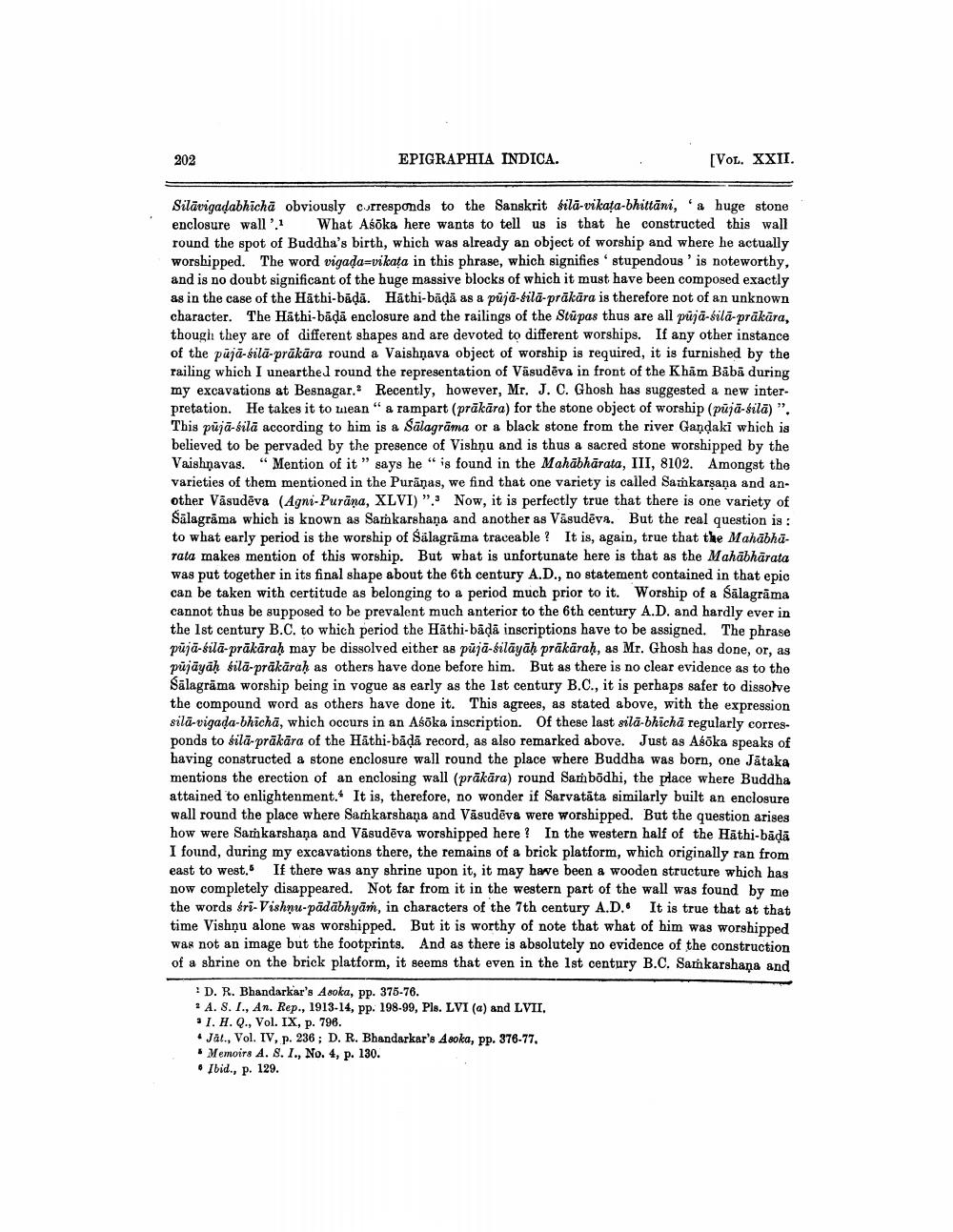________________
202
EPIGRAPHIA INDICA.
[VOL. XXII.
Silāvigadabhichā obviously Curresponds to the Sanskrit filā-vikața-bhittäni, a huge stone enclosure wall'.1 What Aśöka here wants to tell us is that he constructed this wall round the spot of Buddha's birth, which was already an object of worship and where he actually worshipped. The word vigada=vikata in this phrase, which signifies' stupendous' is noteworthy, and is no doubt significant of the huge massive blocks of which it must have been composed exactly as in the case of the Hathi-bādā. Hathi-bādā as a pājā-éilā-prākāra is therefore not of an unknown character. The Hathi-bādā enclosure and the railings of the Stūpas thus are all pūjā-Silā-prākāra, though they are of different shapes and are devoted to different worships. If any other instance of the pūjā-silā-prākāra round a Vaishnava object of worship is required, it is furnished by the railing which I unearthed round the representation of Väsudēva in front of the Khām Bābā during my excavations at Besnagar. Recently, however, Mr. J. C. Ghosh has suggested a new interpretation. He takes it to mean" a rampart (prākāra) for the stone object of worship (pājā-bila)”. This pūjā-silā according to him is a Sālagrāma or a black stone from the river Gandaki which is believed to be pervaded by the presence of Vishņu and is thus a sacred stone worshipped by the Vaishnavas. “Mention of it” says he " is found in the Mahābhārata, III, 8102. Amongst the varieties of them mentioned in the Purāņas, we find that one variety is called Sazkarşana and another Väsudēva (Agni-Purāna, XLVI)".. Now, it is perfectly true that there is one variety of Sālagrāma which is known as Sarkarshana and another as Väsudēva. But the real question is: to what early period is the worship of Sälagrāma traceable? It is, again, true that the Mahābhūrata makes mention of this worship. But what is unfortunate here is that as the Mahābhārata was put together in its final shape about the 6th century A.D., no statement contained in that epic can be taken with certitude as belonging to a period much prior to it. Worship of a Sālagrāma cannot thus be supposed to be prevalent much anterior to the 6th century A.D. and hardly ever in the 1st century B.C. to which period the Hathi-bādā inscriptions have to be assigned. The phrase pājā-bilā-prākāraḥ may be dissolved either as pājā-bilāyāḥ prākāraḥ, as Mr. Ghosh has done, or, as pūjāyāḥ śilā-prākāraḥ as others have done before him. But as there is no clear evidence as to the Salagrāma worship being in vogue as early as the 1st century B.C., it is perhaps safer to dissolve the compound word as others have done it. This agrees, as stated above, with the expression silā-vigada-bhicha, which occurs in an Asöka inscription. Of these last silā-bhichā regularly corresponds to sila-prākāra of the Hathi-bādā record, as also remarked above. Just as Asöka speaks of having constructed a stone enclosure wall round the place where Buddha was born, one Jātaka mentions the erection of an enclosing wall (prākāra) round Sambodhi, the place where Buddha attained to enlightenment. It is, therefore, no wonder if Sarvatāta similarly built an enclosure wall round the place where Samkarshana and Väsudēva were worshipped. But the question arises how were Samkarshana and Väsudēva worshipped here? In the western half of the Hathi-bādā I found, during my excavations there, the remains of a brick platform, which originally ran from east to west. If there was any shrine upon it, it may have been a wooden structure which has now completely disappeared. Not far from it in the western part of the wall was found by me the words sri-Vishnu-pädābhyām, in characters of the 7th century A.D.. It is true that at that time Vishnu alone was worshipped. But it is worthy of note that what of him was worshipped was not an image but the footprints. And as there is absolutely no evidence of the construction of a shrine on the brick platform, it seems that even in the 1st century B.C. Sankarshaņa and
?D. R. Bhandarkar's Asoka, pp. 375-76. ? A. 8. I., An. Rep., 1913-14, pp. 198-99, Pls. LVI (a) and LVII. : 1. H.Q., Vol. IX, p. 796. 4 Jal., Vol. IV, p. 236; D. R. Bhandarkar's Asoka, pp. 376-77.
Memoirs A. S. 1., No. 4, p. 130. • Ibid., p. 129.




